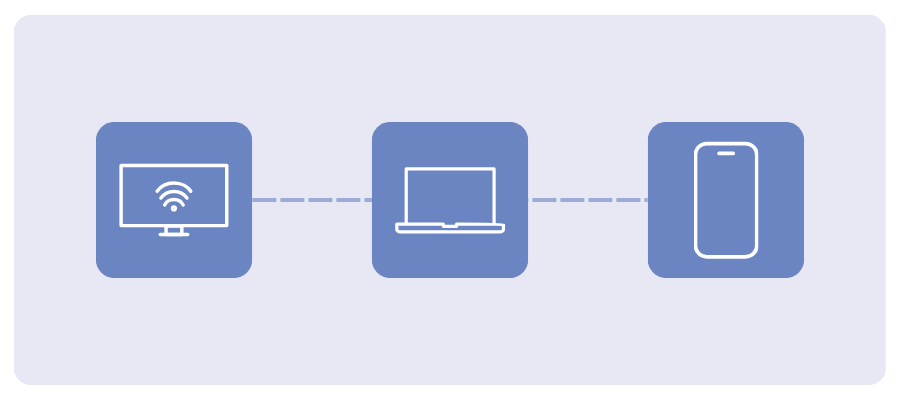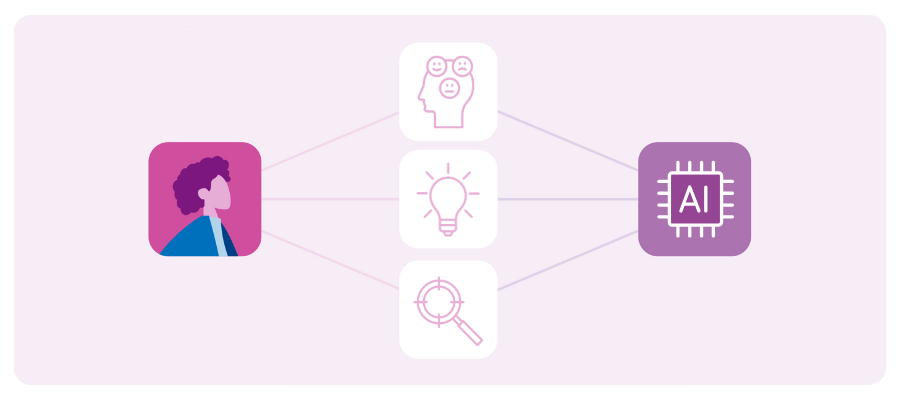At A Glance
Marketers are using AI to better understand audiences, improve efficiency, and build privacy-first identity solutions. At Cannes Lions 2025, leaders shared how AI and structured data help deliver relevant messages, adapt to consumer needs, and build trust. Experian supports this through ethical efforts and innovative solutions.Artificial intelligence (AI) is becoming a bigger part of modern advertising, changing how brands connect with people. At Experian, we believe this technology should make marketing more human, not less. We use AI to help marketers understand consumer behavior, respect privacy, and deliver messages that matter.
As part of our latest Cannes Content Studio series, we spoke with leaders from AdRoll, MiQ, OpenX, Optable, PMG, PubMatic, and Yieldmo. Their insights show a clear path forward; one where technology supports human strategy to create more meaningful connections.
1. How does AI help you see audiences more clearly?

AI decodes complex behavioral signals to reveal the values and mindsets behind decisions, and increasingly, it predicts what audiences will care about next. This allows marketers to deliver timely, relevant messages that resonate with audiences. At Experian, we help brands use these insights to connect more meaningfully and ethically.
Takeaway: Experian’s tools help brands uncover audience insights, enabling more meaningful and ethical connections.
2. Where does AI actually save time, and improve results?

Running campaigns is time-consuming. Solutions like Agentic AI now orchestrate end-to-end campaign workflows, audience building, trafficking, QA, pacing, and routine optimizations, so teams focus on strategy and creativity. Many leaders (94%) are investing broadly in AI to drive efficiency and impact, and 49% of marketers use it daily for image and video generation, shifting repetitive tasks from people to tools. By quickly combining past and current performance data, AI can pre-optimize before launch and refine mid-flight, while marketers steer the message and experience.
“AI uses past campaign data to optimize performance before launch, continues learning during the campaign, and refines strategies based on the insights it generates, driving better results over time.”
PubMaticHoward Luks
Takeaway: Experian’s solutions streamline campaign workflows, allowing marketers to focus on creativity and strategy while improving results.
3. How do AI and human strategy work together in real time?

AI handles real-time data analysis and optimization, freeing marketers to focus on strategy, messaging, and creativity. By defining audiences once and activating them across platforms, teams can adapt quickly and confidently. At Experian, we combine machine intelligence with human insight to deliver smarter, more agile campaigns.
“AI analyzes data, pulls insights, and automates optimizations, allowing marketers to focus on strategy, messaging, and creativity instead of spending time digging through numbers and data.”
AdRollLizzie Chapman
Takeaway: Experian solutions empower marketers to adapt quickly and confidently, combining human strategy with insights.
4. What does privacy-first look like now?

Relying on simple, static data points is no longer enough. A modern approach to identity blends deterministic data (like known identifiers) with modeled components, ensuring data remains de-identified where possible. Clear, transparent guardrails, permitted-use policies, retention limits, sensitive-category blocks, and audit trails, help brands balance personalization with privacy, build trust, and respect user choice.
“A new blend of identity systems combines deterministic data, known identifiers, and model driven components, creating fresh ways to address identity and activate campaigns with precision.”
OptableVlad Stesin
Takeaway: Experian’s privacy-first identity solutions help brands balance personalization with safety, ensuring trust and compliance.
5. Which new data signals matter, and why?

AI is unlocking a new generation of data signals, like content context, sentiment, emotional tone, suitability, attention, and commerce intent, that go beyond legacy identifiers like cookies and demographics. These signals can help brand messages appear in the most relevant environments and by high-value audiences. Used well, they improve relevance, avoid placements near unsuitable or off-brand content, and drive stronger campaign outcomes.
“Unlocking new data sets (like emotion, sentiment, and context), AI is creating innovative ways to connect client content with advertising opportunities and rethink how we approach the market.”
PMGSam Bloom
Takeaway: Experian’s solutions use advanced data signals to help marketers create more effective and innovative campaigns.
Why Experian for human-centered AI?

We deliver on the promise of AI-powered marketing through five pillars:
- See audiences clearly across households, individuals, and devices.
- Recommend next‑best audiences and automate setup for faster execution.
- Adapt in real‑time to keep relevance high.
- Innovate responsibly with strong governance and transparency.
- Plan, activate, and measure campaigns on one unified platform.
The future of intelligent marketing

AI will keep accelerating, but the goal stands: make marketing more human. Teams that blend privacy‑first identity, predictive insight, AI‑powered simplicity, and real‑time intelligence will earn trust and drive outcomes. Experian helps you bring those pieces together so every campaign moves from assumptions to clarity, and from activity to measurable results.
Talk to Experian about building human-centered AI into your marketing strategy
AI marketing trends FAQs
AI analyzes complex signals, behaviors, values, and mindsets to provide a clearer picture of what matters to audiences. That clarity makes messaging feel personal and relevant. Learn more about Experian’s Digital Graph and how it can help marketers understand audiences better.
Automation reduces manual setup and reporting, so teams focus on strategy and creative. Nearly half of marketers (49%) use AI daily for image and video generation, reflecting this shift.
Smarter activation across platforms means defining audiences once, then carrying them across channels with live feedback, so relevance and suitability stay high. See how Experian enables smarter activation with our data and identity solutions.
Privacy‑first identity blends deterministic and modeled components, keeping data de‑identified where possible. Experian’s solutions balance personalization with safety. Learn about Experian’s identity solutions is changing identity.
AI systems rely heavily on brand‑managed sources. 86% of citations come from websites, listings, and reviews, so clean, accurate, structured data makes your answers and your brand more discoverable. Discover how Experian supports structured data for AI-driven marketing.
Latest posts

At the recent Beet Retreat 2023 in Santa Monica, a fireside chat featuring Kimberly Gilberti, Experian’s Chief Product Officer, shed light on how connected TV (CTV) is changing content delivery and introducing a profound shift in audience engagement and advertising strategies. In this blog post, we’ll recap Gilberti’s discussion about advertising on CTV. CTV's transformative impact on media consumption CTV brings together the nostalgia of traditional television and the cutting-edge capabilities of digital targeting, opening new doors for advertisers to connect more meaningfully with audiences. This integration heralds a new wave of viewer engagement opportunities. The revolution goes beyond altering content consumption modes; it fundamentally transforms how audiences interact with media. Advertisers now have the tools to forge deeper, more personalized connections with their audience, thanks to CTV. "The evolution of media is exciting, offering endless opportunities due to the vast inventory and engaged audiences. The key to using this is understanding the consumer, the 'who' behind the viewing."kimberly gilberti, chief product officer The evolution of advertising on CTV In CTV, traditional advertising strategies are being re-evaluated. Advertisers must pivot to meet changing viewer trends, focusing on campaigns that resonate on a personal level and harness the targeted delivery capabilities of the medium. Data and technology stand at the forefront of advertising on CTV. Effective collection, analysis, and application of audience data are crucial for creating impactful CTV campaigns. Advanced analytics tools are essential in deciphering complex viewer habits. Companies like Experian are key players, offering the necessary tools and insights for advertisers to navigate the CTV space effectively. "Experian's unique data assets are incredibly valuable. We understand consumers wherever they are, connecting the offline and online worlds. Our database, rooted in real people's information, is extensive and privacy-focused, covering virtually every U.S. household."kimberly gilberti, chief product officer The complexities and opportunities in advertising on CTV Even though the CTV landscape is filled with vast opportunities and significant challenges, one major hurdle is accurately identifying viewers within shared household accounts, complicating targeted advertising on CTV efforts. Additionally, the fragmentation of content across multiple streaming platforms amplifies the challenge of reaching specific audience segments. The presence of 'walled gardens' adds another layer of complexity in achieving a comprehensive understanding of audience behavior across different platforms. Despite these challenges, the potential for effective, personalized advertising on CTV is immense. Key to unlocking this potential is the accurate measurement of ROI and the alignment of content with viewer preferences. These areas of focus underscore the need for sophisticated identity resolution and audience analysis solutions. Collaboration is the key to unlocking CTV's potential The future of advertising on CTV relies on collaboration. Joint efforts from advertisers, agencies, technology providers, and publishers are essential for sharing data and insights while maintaining consumer privacy. This collective approach is pivotal in tackling the challenges of advertising on CTV and harnessing its full potential. As the industry dives deeper into the CTV landscape, insights from Beet Retreat 2023 and leaders like Gilberti underscore the importance of understanding and engaging with your consumers. The collaborative efforts of the industry, bolstered by technological and data-driven expertise, are critical in capitalizing on the power of CTV. Experian’s Collaboration solution connects our client's and partner's data to unlock more robust insights, smarter activation, and more holistic measurement for online and offline media efforts. To learn more about what our data collaboration services can do for your business in this new era of CTV, visit our website or connect with a member of our team today. Start collaborating with Experian Latest posts

In the fast-paced advertising world, collaboration is crucial to keep up with the flux in consumer behaviors. Samsung Ads and Experian have joined forces to address this challenge. This partnership aims to equip marketers with the necessary tools and insights to create compelling and impactful content that resonates with the right audience at the right time. By combining our expertise and precision, through this new partnership, we promise to maximize the reach, effectiveness, and efficiency of advertising campaigns. This collaboration ensures that marketing messages get noticed and strike a chord with the intended audience, leading to meaningful engagement and measurable outcomes. The Samsung Ads and Experian collaboration The powerful integration between Samsung Ads and Experian brings together Samsung Ads’ industry-leading viewership data and massive device scale with the detailed data insights of Experian. This combined effort enhances the effectiveness of advertising campaigns by merging scale with precision. Advertisers can now reap the benefits of a comprehensive solution that delivers customized content to a wide audience with unparalleled accuracy. “Navigating the dynamic landscape of digital advertising requires innovative solutions and strategic collaborations. This partnership with Samsung Ads exemplifies our commitment to empowering advertisers with data-driven insights that reach and resonate with audiences. With Experian Marketing Data directly accessible within the Samsung DSP, advertisers are equipped to orchestrate campaigns with unprecedented precision and impact, marking a significant stride in personalized advertising." chris feo, svp, sales & partnerships, experian Samsung Ads: Orchestrating reach and precision Samsung Ads’ suite of advertising solutions uses Samsung’s massive global scale to bring advertisers unmatched opportunities to engage consumers across every screen, during every moment that matters, delivering quantifiable results on a massive scale. Samsung DSP: Key features and benefits Samsung Ads believes that smarter advertising doesn’t need to be more complicated. With Samsung DSP, every intuitive feature is engineered to make media simple again, offering advertisers the ability to reach their audience more effectively, across every screen. Addressable TV Transforms traditional viewing experiences by delivering personalized content to specific households, enhancing engagement and connection. Contextual targeting Nurtures audience engagement by placing ads in relevant content environments that amplify their relevance and impact. Global reach Navigate the digital expanse with agility, delivering content to millions of consumers across devices and platforms, in brand-safe environments. Data-driven targeting Combine Samsung Ads' unrivaled proprietary device data with Experian's insights, to translate global reach into personalized consumer engagement. “The new partnership between Experian and Samsung Ads is an exciting development for advertisers as they look to maximize the effectiveness of their marketing campaigns. With hands-on access to Experian’s identity solution and audiences directly within our platform, Samsung DSP, advertisers can now better address their most important audiences on the screens they use most.”alex boras, platform lead, samsung dsp Why choose Experian in Samsung At Experian, data is more than just numbers; it tells detailed stories about what consumers like, how they behave, and their experiences. Each piece of data supports the connective networks that offer advertisers nuanced insights and actionable strategies. Ease of use Experian syndicated audiences take the guesswork out of developing segments, and they are available turnkey on the Samsung Ads shelf. Expansive reach, scale, and flexibility Our breadth and depth of data ensures detailed and targeted insights, spanning multiple verticals and can be directly attached to households, providing contextual relevance to each consumer's behaviors and purchase patterns. A rich data set that encompasses 126 million households and 750 million hashed emails 5,000 data attributes for enrichment, licensing, and audience creation 2,400 ready-to-use audiences on integrated platforms spanning 8 verticals, complemented by an average of 2,300 attributes per household and 250 attributes per consumer Four benefits to advertisers The partnership between Samsung Ads and Experian offers a plethora of benefits to advertisers, including: Enhanced audience targeting You can use Samsung Ads' ACR data and Experian's syndicated audiences to create highly targeted campaigns that reach the right audience at the right time. This can lead to significant improvements in campaign performance, such as increased engagement, conversion rates, and ROI. Optimized ad spend You can reduce wasted ad spend by using Experian's data to identify and avoid audiences less likely to be interested in your products or services. This can help you get the most out of your advertising budget. Improved attribution You can better understand the consumer journey by tracking how audiences interact with your ads across different devices and platforms. This information can be used to optimize campaigns and improve overall performance. Brand safety You can ensure that your ads are displayed in safe and secure environments by using Samsung Ads' brand safety solutions. This helps to protect brand integrity and reputation. Samsung and Experian are steering the future of advertising Together, our goal is to bring personalized and improved ad experiences to the forefront. This partnership allows advertisers to tailor their ads to individual consumer interests and needs, using the rich consumer data insights provided by Experian. Additionally, the partnership offers measurable aspects that allow advertisers to assess the effectiveness of their campaigns across various platforms, increasing their return on investment. By enhancing the overall ad experience, Samsung and Experian ensure that ads are more relevant and less intrusive, improving consumer engagement. Connect with us to learn more about how you can access our syndicated audiences in Samsung’s DSP. To learn more about our partner Samsung Ads, visit SamsungAds.com. Latest posts

Industry leaders recently gathered at the influential Beet Retreat 2023 conference held in Santa Monica, sharing forward-looking perspectives on the future of advertising. This renowned event known for its diverse mix of leaders from TV, agencies, advertising, and technology sectors, was enriched by insights from Experian’s very own Chris Feo, SVP of Sales & Partnerships, and Kimberly Gilberti, Chief Product Officer. Both Feo and Gilberti brought their expertise and perspectives for harnessing the potential of high-growth connected TV (CTV) advertising. The era of connected everything at Beet Retreat 2023 In the “Era of Connected Everything,” panel, Feo dived into the concept of a ‘connected everything’ world. He emphasized the importance of balancing consumer and privacy expectations with the increasing integration of AI and machine learning. “As decisioning evolves, creative tech and data derived from creative scale will play a bigger role.”chris feo, svp, sales & partnerships Feo further discussed the potential of creative technology, particularly in how AI and machine learning could revolutionize content personalization. He cited examples where the same creative content is used indiscriminately across diverse demographics, suggesting a future where creative content adapts and performs well for a variety of audience identities. Experian's balanced approach at Beet Retreat 2023 During a fireside chat, Gilberti shared her vision on the transformative role of television in the advertising technology landscape. “Connecting exposure to business outcomes is the holy grail of measuring CTV and effectiveness.”kimberly gilberti, chief product officer Her insights reflected the growing interplay between digital and traditional TV advertising, and the opportunities arising from this convergence. Gilberti emphasized the critical role of data analytics in enabling advertisers to tailor content more effectively to diverse TV audiences. She envisioned a future where the integration of digital strategies and traditional TV advertising create a more cohesive and impactful AdTech approach. Future focus: Diversification and partnerships Both Feo and Gilberti underscored the need for advertisers to diversify their partnerships. By working with a variety of partners, you can mitigate risks and foster innovation, ensuring you are not overly dependent on a single channel or approach. Navigate what’s next with Experian Experian's contributions at Beat Retreat 2023 underscore our pivotal role in the AdTech industry. With a unique balance of offline and online data expertise, we are not just adapting to changes but leading the way in innovation and strategy. Our insights and approaches, as highlighted by Feo and Gilberti, demonstrate our commitment to guiding the industry through its rapid evolution, making our role indispensable in the future of advertising technology. At Experian, we’re your partner in data-driven marketing and can help make your interactions more meaningful. To learn more, connect with a member of our team today. Connect with us Latest posts